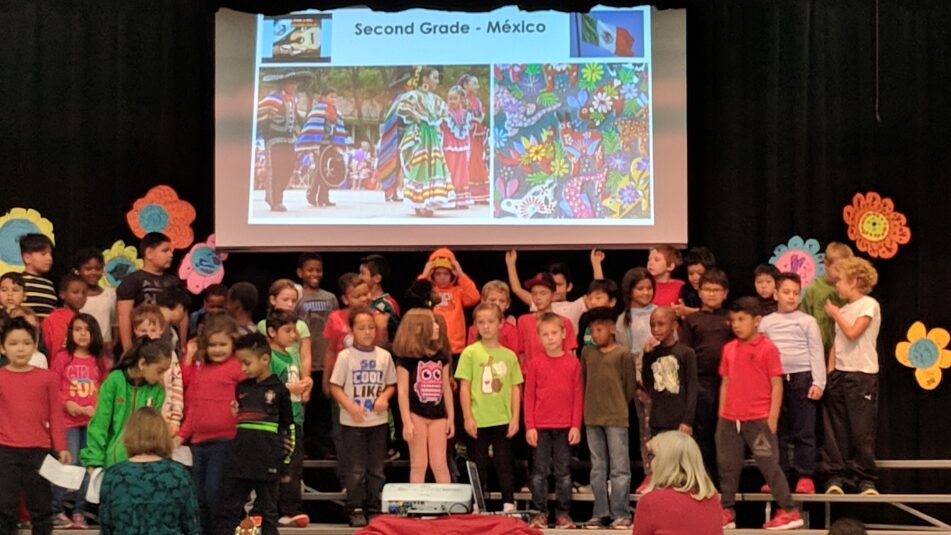At Mitchell Elementary, this month is one of the highlights of the year
By Jo Mathis/AAPS District News Editor
Because it coincides with the busy start of the school year, the national Hispanic Heritage Month (Sept. 15 to Oct. 15) is sometimes overlooked.
But that’s not the case at AAPS, where students will learn about the culture, geography, art, music, sports, and people of Hispanic countries throughout the month.

Hispanic Heritage Month is a particularly big deal at Mitchell Elementary, where students school-wide have started their Hispanic Heritage Month Unit, which will last for a month.
“Growing up, I remember being very curious about my Chilean heritage,” says Christopher Culbertson, EL teacher at Mitchell. “I didn’t see many examples of my own heritage in Ann Arbor or at school. Celebrating Hispanic and Latinx Heritage is important because it provides an opportunity for children to see themselves reflected in their academic lives.”

Mitchell Spanish teacher Rachel Gryak notes that pre-COVID, the month would end with a celebratory assembly in late October, although this year student learning may be shared either through a Zoom performance and/or student videos that get shared with families.
Students learn about a different country in each grade, Gryak says, adding that students learn about a specific country as well as influential Hispanic Americans in Spanish class, as well as art, music, library, and physical education.
“Students also make cross curricular connections in art, music, physical education, library, and with their classroom teachers,” she says. “We also partner with local artists and authors to share their work with students. Families are encouraged to make connections at home and bring in artifacts to share.”
This year, Mitchell is conducting a school-wide author study of Hispanic American author René Colato Laínez of El Salvador and read his books in class and library. These are the countries each grade focuses on: PreK/Y5: Bolivia; K: El Salvador; 1: Puerto Rico; 2: México; 3: Argentina; 4: Honduras; 5: Cuba/Spain.
Eberwhite second grade teacher Kelsey Lafferty Friend says Hispanic/Latinx Heritage Month is important to teach to make sure students see themselves represented in the classroom.
“It is equally important that we do not choose literature only during the months of September and October but students are seeing themselves represented throughout our classroom all year long,” she says. “This is also an opportunity for many students to experience a window or sliding glass door and learn more about a culture that is not their own. Throughout Hispanic/Latinx Heritage Month we do activities that a colleague, Chris Culbertson, at Mitchell Elementary told me about, read books written by hispanic/latinx authors and learn about a influential hispanic/latinx individuals that have paved the way for our future.”
She say she also includes Latinx for others that prefer the gender neutral term rather than Latino/Latina, acknowledging that Hispanic refers to people who speak Spanish and/or are descended from Spanish-speaking populations, while Latino refers to people who are from or descended from people from Latin America.

A national celebration
Each year, Americans observe National Hispanic Heritage Month from September 15 to October 15, by celebrating the contributions and importance of Hispanics and Latinos to the United States and those American citizens whose ancestors came from Spain, Mexico, the Caribbean, Central America, and South America. The NCHEPM supports the federal government’s observance activities each year by leading the process to select the annual theme federal agencies will use to conduct their Hispanic Heritage Month observances.
The Hispanic Heritage observance began in 1968 as Hispanic Heritage Week under President Lyndon Johnson and was expanded by President Ronald Reagan in 1988 to cover a 30-day period starting on September 15 and ending on October 15. Americans are encouraged to celebrate the contributions and importance of Hispanics and Latinos to the United States and those American citizens whose ancestors came from Spain, Mexico, the Caribbean, Central America, and South America.
Vanessa SanMiguel, Mitchell’s building literacy expert has helped shape the unit by emphasizing the importance of focusing on indigenous peoples in each country of study and their influence and impact on the country and culture.


Be the first to comment